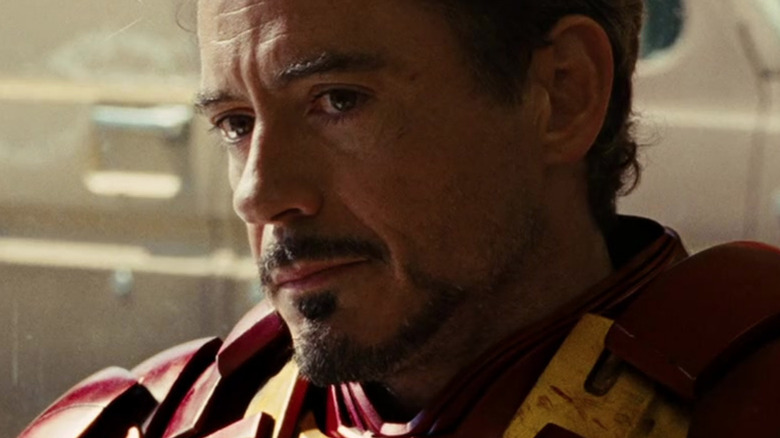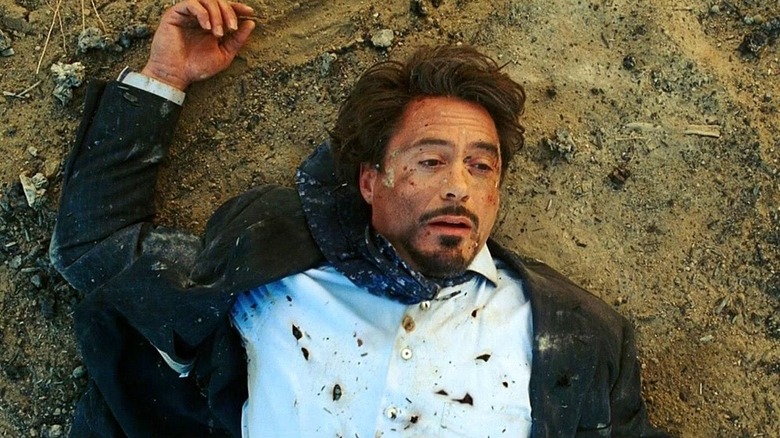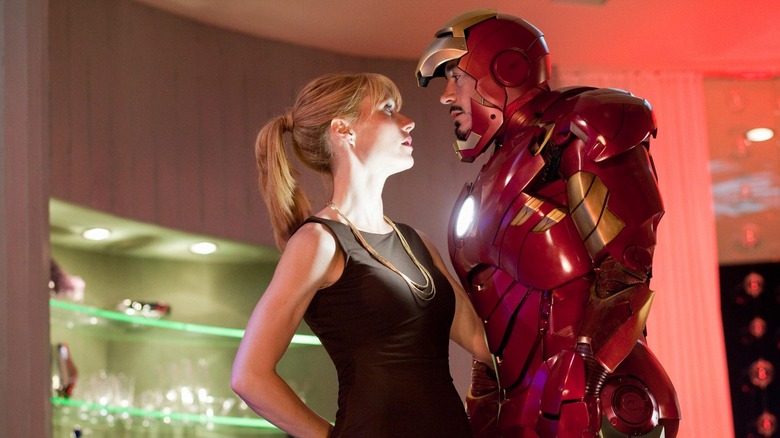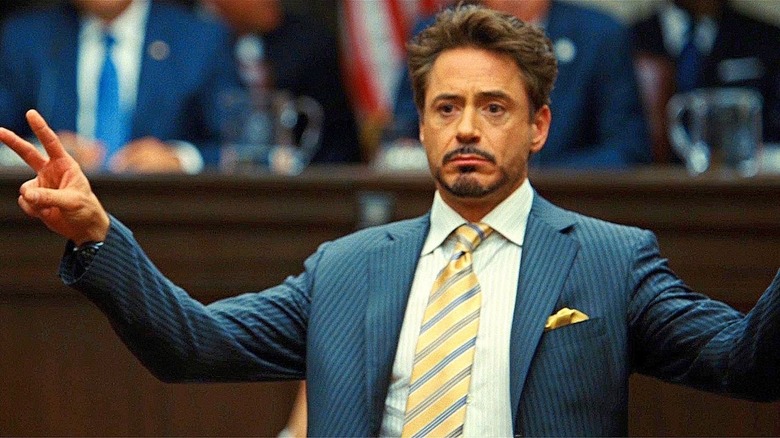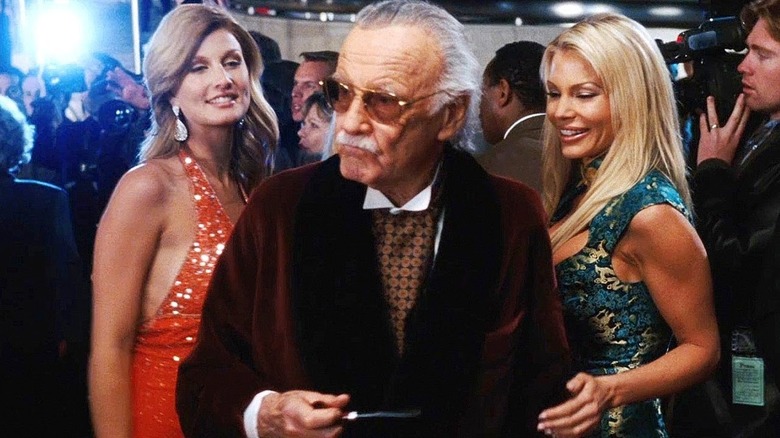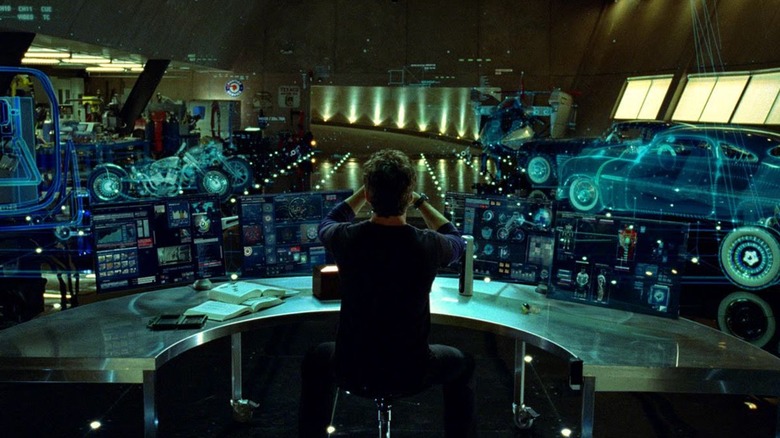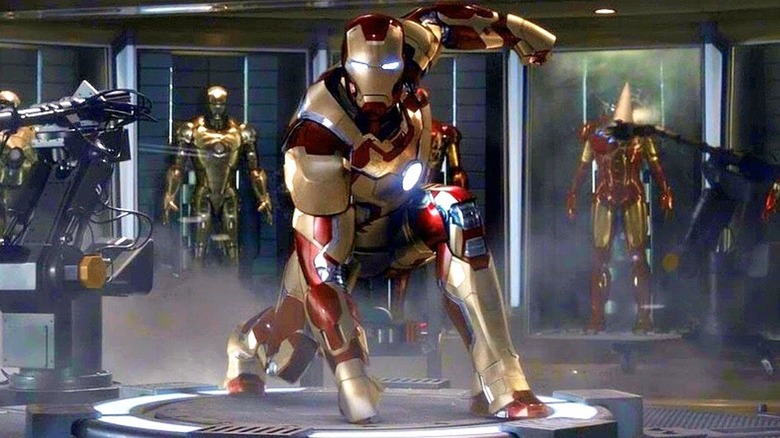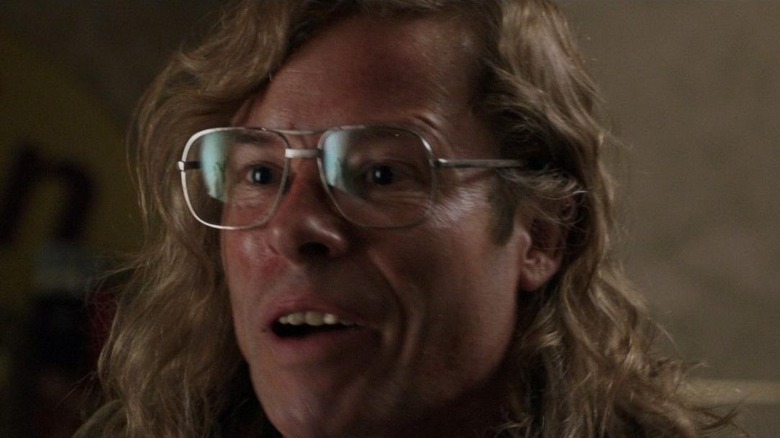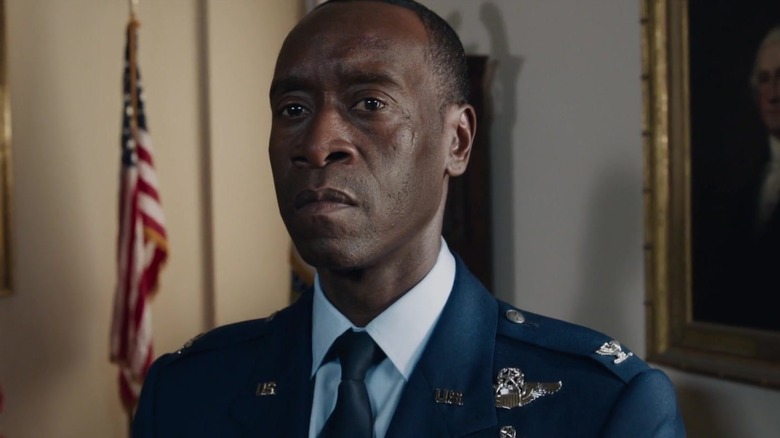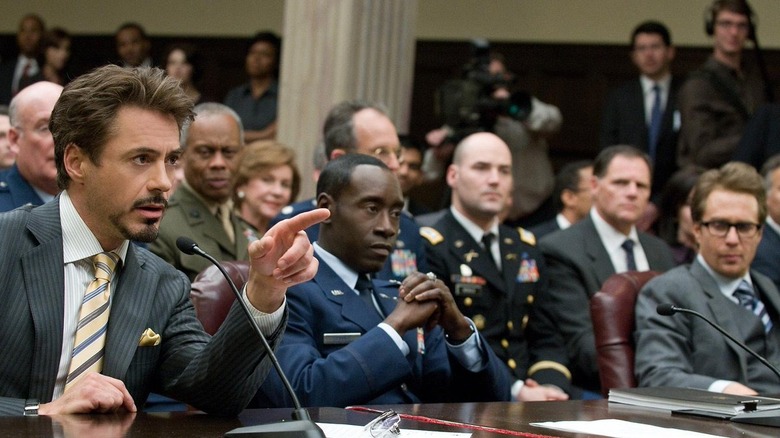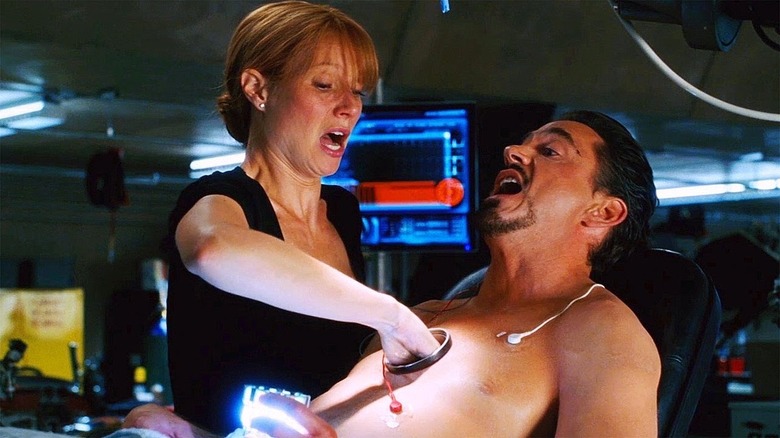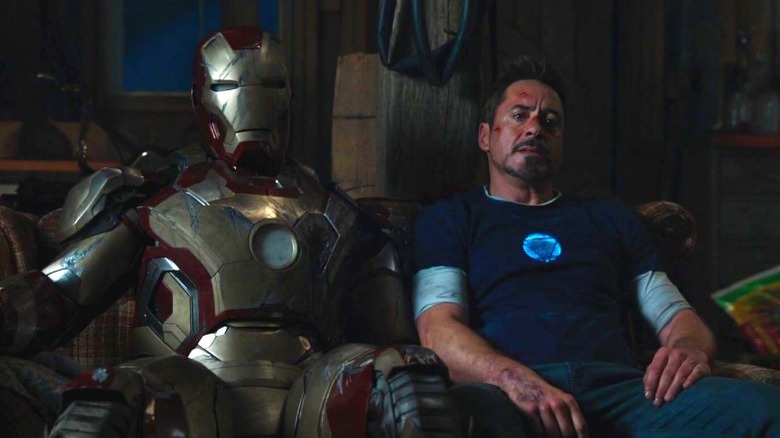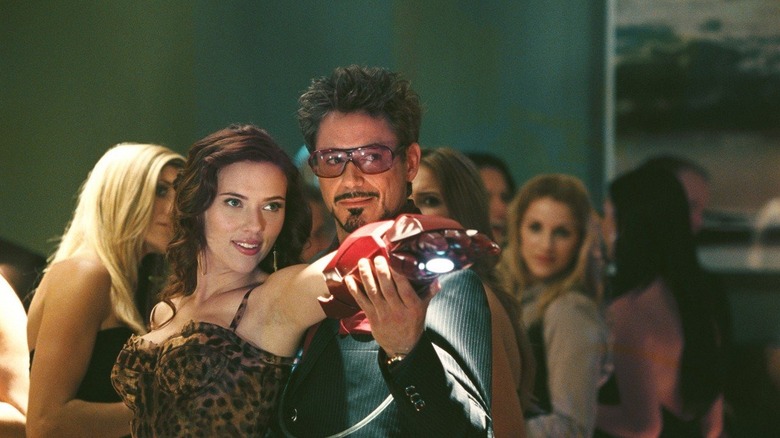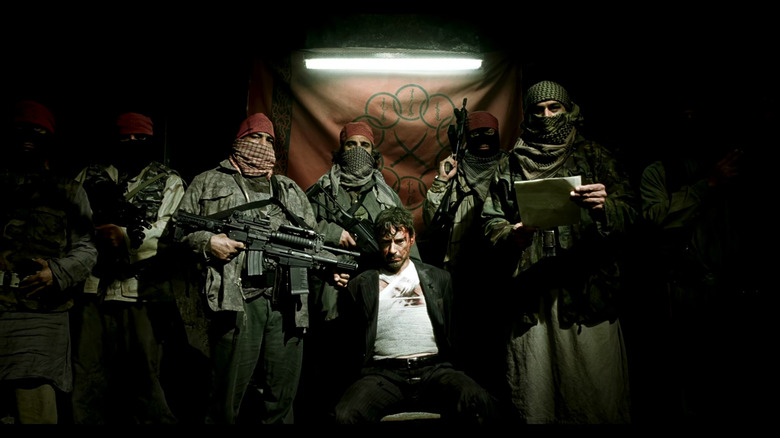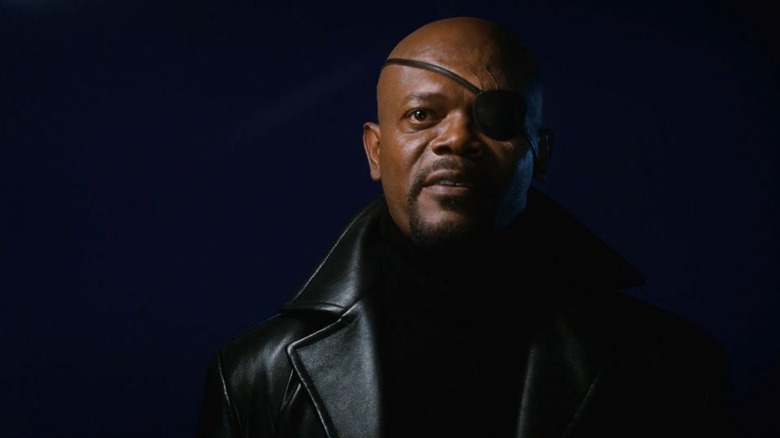Things That Happen In Every Iron Man Movie
It would be difficult to overstate the importance of Robert Downey Jr. in the role of Tony Stark aka Iron Man in the Marvel Cinematic Universe. It was Iron Man's first solo movie released in 2008 that kickstarted the MCU with a film beloved by critics as well as audiences for its cool, gritty, high-concept approach to superhero filmmaking.
After that, Tony was firmly established as the center of the MCU, the focal point of the band of heroes who would eventually become the Avengers, and the guy whose sacrifice at the end of "Avengers: Endgame" would conclude the first three phases of the MCU in a memorable manner. Along with his appearances in movies featuring other MCU heroes, Tony Stark also got a full trilogy of solo films to chart his personal journey.
These solo movies starring Iron Man are of varying quality, but they are consistent in moving Tony Stark's character forward from the place he starts at the beginning of the original "Iron Man." Despite featuring different narratives and themes, certain plot points keep cropping up in each movie in the trilogy. Here are a few plot points you can find in each "Iron Man" film.
Tony Stark must learn humility
Anyone even vaguely familiar with Tony Stark knows the character suffers from a massive superiority complex. Tony is a world-changing genius, and he is highly aware of that fact. This leads Tony to believe that he knows better than everyone else, all the time, to the frustration of his allies and the advantage of his enemies.
That is why a major plot point in each "Iron Man" movie is Tony learning humility the hard way. In the first film, Tony starts out an arrogant and selfish weapons manufacturer. It is only after he is captured by terrorists that Tony sees the destruction caused by his weapons and vows to stop making them.
In the second movie, Tony has trouble finding a solution to his deadly illness. Bereft of all hope, Tony realizes in a humbling moment that even his great intelligence is not enough to rescue him from this condition, and he has to rely on his father's help from beyond the grave to find a solution.
Finally, in the third movie, all of Tony's trademark arrogance literally gets thrown out the window when a mysterious terrorist that calls himself the Mandarin (Ben Kingsley) attacks him in his own home in broad daylight. Tony is forced to concede he cannot handle this new threat alone and needs the help of his friends to defeat the villain while keeping a grip on his PTSD.
Pepper is Tony's rock
Female love interests in the MCU too often get the short end of the stick, only being present to provide some humanizing moments for the hero before fading into the background in time for the big fight between the hero and the villain. But Tony's longtime love interest, Pepper Potts (Gwyneth Paltrow), bucks this trend by being an important part of the "Iron Man" films.
Pepper starts out as Tony's assistant, and the closest thing to a companion he has in his jet-setting, playboy life. All through the movie, Pepper supports Tony, even saving his life at one point as the two grow closer together. In the second film, Tony and Pepper are officially a couple. Dealing with his personal illness, Tony makes Pepper the head of Stark Industries, and she takes over the entire organization on Tony's behalf.
But it is "Iron Man 3" when Tony needs Pepper the most. Struggling to control his PTSD following the Battle of New York in "The Avengers," Tony leans hard on Pepper to keep him going through his insomnia and night terrors. In the end, Pepper once again personally saves Tony's life when she also briefly gains superpowers and helps Tony fight Aldrich Killian (Guy Pearce).
Tony brags about his greatness
One major reason why Tony Stark felt like a breath of fresh air in the first "Iron Man" is that his characterization is so different from Superman, Batman, and Spider-Man, the three main solo heroes at the time whom the public was most familiar with. All those heroes tend to have tortured inner lives with an unhealthy amount of angst.
Tony is refreshingly free of such a mentality and does not usually suffer from a great deal of self-doubt. In fact, Tony is so convinced of his own personal greatness that he is far more likely to brag about his achievements than cry over his mistakes. That is why every "Iron Man" movie has plenty of instances of Tony reminding his friends and enemies just how smart and capable and awesome he is.
The crowning moment in this regard comes at the end of the first "Iron Man," when Tony, in front of the whole world, grandly declares, "I am Iron Man." In the next film, Tony informs a court convened against him, "I've successfully privatized world peace." Then we have this gem from "Iron Man 3," when Tony states, "I'm Tony Stark. I build neat stuff, got a great girl, occasionally save the world. So why can't I sleep?"
A Stan Lee cameo
Before he passed away, comic book legend Stan Lee had a great fondness for appearing in Marvel movies in brief cameos. Since most Marvel movies before the MCU were pretty bad outside of "Spider-Man" and the "X-Men," there were not a lot of great stories mined from Marvel Comics for the big screen that Stan Lee could be a part of. (Though that didn't stop him from appearing anyway.)
But all that changed with "Iron Man," and the start of the MCU. Stan Lee appears in each "Iron Man" movie, and continued to appear in every MCU film until his death around the release of "Avengers: Endgame." In the first "Iron Man," Lee appears as a Hugh Hefner-type playboy attending the same party as Tony Stark. In the second film, Lee plays a Larry King-type of newsman whom Tony meets at the Stark Expo. Finally in "Iron Man 3," Lee appears as a judge at a beauty contest who seems very impressed by one of the contestants. For his part, Lee was a big fan of Robert Downey Jr. as Iron Man. "I think [Downey and Chris Evans] were born to play their roles," Lee once told the Toronto Sun. "As long as they will continue to play them, I think we'll be very lucky."
Tony has an AI sidekick
More than any other superhero in the MCU, Iron Man's mystique comes from the array of futuristic gadgets that turn regular old Tony Stark into someone capable of keeping up with the likes of Thor (Chris Hemsworth) and trading punches with Thanos (Josh Brolin) without immediately being pulverized. Naturally, the production team of the "Iron Man" films needed to come up with appropriately cool stuff to put in Tony's research lab where he comes up with his inventions.
The coolest addition to the lab was JARVIS (Just A Rather Very Intelligent System), Tony's personal assistant AI that helps him control his machines and is also a major help in flying the Iron Man armor. JARVIS is not just a robotic character. It speaks as a person with a distinct personality and also appears to have adopted Tony's sarcasm.
The role of JARVIS was played by Paul Bettany in the first three "Iron Man" movies. "I walk in, I say some lines on a piece of paper for two hours," Bettany told Digital Spy about voicing JARVIS. "And then they give me a bag of money and I leave and I go about my day." After that, the character was reimagined as the android superhero Vision following the events of "Avengers: Age of Ultron," and Bettany now spends ages in the makeup chair (and sometimes in a sauna with red wine at the end of the day), quite the opposite experience to voicing Tony's AI.
Tony upgrades his suit
Tony Stark is known by many titles. Playboy. Billionaire. Philanthropist. Superhero. But before all of that, Tony is at his core an engineer and an inventor. The entire saga of the Iron Man armor begins in the first movie because Tony is captured by terrorists and the only way to escape is to create a suit of armor that could get him out of the situation.
The first Iron Man suit Tony builds "in a cave with a box of scraps," and it's a very rough affair, big and bulky and not very fuel-efficient. After returning home, Tony gets to work creating a better-designed version of the suit that becomes the iconic red-and-gold Iron Man armor audiences all over the world fell in love with.
With each new movie after that, including the "Avengers" flicks, Tony debuts new versions of the classic Iron Man suit. There's the emergency suit hidden in a suitcase from "Iron Man 2." There's the army of suits from "Iron Man 3" Tony feverishly builds and destroys in his quest to keep the world safe. The Hulkbuster armor from "Avengers: Age of Ultron" and "Infinity War." And finally, the nanotech suit that Tony wears in his battle against Thanos and his army.
The villain was scorned by Tony
The "Iron Man" films are considered the starting point for the MCU. This is not just because they were the first movies in the franchise to get widespread critical acclaim and massive box office numbers, but also because many of the plot points from the "Iron Man" movies became a staple of the MCU as whole. For instance, Tony's quippy nature has come to be shared by many other heroes, as has the "the villain has the same power set as the hero" thing started by Obadiah Stane (Jeff Bridges).
The villain also tends to be someone whom the hero has scorned in the past. In "Iron Man," Tony is too busy working on dismantling his past as a weapons manufacturer to realize that his actions are negatively affecting his company's second-in-command, Obadiah. This leads to the No. 2 stepping up his efforts to usurp Tony from the company and kill him off. In "Iron Man 2," Justin Hammer (Sam Rockwell) was a rival weapons manufacturer who had spent a lifetime being bested by Tony in their field of work, and was actively looking for an opportunity to one-up Tony by stealing and improving upon his Iron Man armor design, aided by Ivan Vanko aka Whiplash (Mickey Rourke), whose family was spurned by Stark's. Finally, in "Iron Man 3," Aldrich Killian was a researcher whom Tony had once dismissed and embarrassed. As a result, Killian builds his own company and dreams of the day he can finally defeat Tony Stark.
Rhodey does what he is not supposed to
If Pepper Potts is the voice of reason in Tony Stark's life and JARVIS is the blindly faithful ally who will do anything Tony asks, James "Rhodey" Rhodes (Terrence Howard and Don Cheadle) is a balance between the two in Tony's inner circle. Rhodey was Tony's friend long before he became Iron Man, and he feels a personal obligation to look out for his reckless friend even if it means breaking the rules or angering Tony himself.
As a high-ranking member of the United States Air Force, Rhodey is often torn between his duty and his friendship with Tony. In the first "Iron Man," Rhodey is forced to hide the fact that it is Tony inside the Iron Man armor getting into an impromptu dogfight against a couple of F-22 Raptors. In "Iron Man 2," irked by Tony's increasingly unstable behavior, Rhodey is forced to go against his wishes and confiscate a prototype version of the Iron Man armor to bring to the US Air Force behind Tony's back.
Then in "Iron Man 3," Rhodey has become a new superhero named Iron Patriot. Once again, Rhodey is forced to work outside the law when his suit gets controlled by the villain to assassinate the president, as ordered by Alrich Killian. This time, Rhodey and Tony both work in secret to bring down the villain's plan.
Tony refuses to play ball with the government
The world of comic books is roughly divided into two. You have the heroes who believe in working within the law. And the heroes who believe in working outside of it. In the case of Tony Stark, you have a little bit of both. While Tony's chief priority is making the world a better, safer place, he has no interest in doing so by working alongside the government, at least in the "Iron Man" films.
In the first movie, Tony abruptly shuts down his weapons manufacturing company that had been supplying the government with military arms for decades. He also tries to keep his identity as Iron Man a secret before once again abruptly letting the cat out of the bag right at the very end of the film with the iconic line "I am Iron Man." Then "Iron Man 2" deals with the fallout of Tony's dramatic declaration as the government tries to force him to share the tech behind his armor. But Tony steadfastly refuses, telling the court, "You want my property. You can't have it." Finally in "Iron Man 3," Tony and Rhodey discover a plot against the US president orchestrated by the vice president and Aldrich Killian, and they work together in secret against government forces to foil the plot.
Ironically, Tony works with the government much better in the "Avengers" movies, joining SHIELD despite his suspicions of their motives. After causing the events of "Avengers: Age of Ultron," Tony signs the Sokovia Accords as a means of atoning for his actions.
Tony has a life-threatening injury
On his own, Tony Stark can be a pretty impossible character to root for. A self-described "Genius billionaire playboy philanthropist," Tony combines extreme intelligence with extreme arrogance and snark. He can be hard for general audiences to like, let alone actively support if we don't get to see Tony in a vulnerable position from time to time.
To offset his many, many advantages in life, every "Iron Man" movie has a major plot point about Tony struggling with a life-threatening condition. In the first movie, Tony gets severely injured in an explosion, and the only way to keep him alive is through the miniaturized arc reactor that he invents and places in his chest. In "Iron Man 2," it is revealed that the arc reactor has started to poison his entire body. Once again Tony races against time to find a cure for his condition before the poison can shut down his body. In the final film, Tony suffers from PTSD, which leaves him a quivering mess and leads him to make mistakes that almost get him killed. In this way, each "Iron Man" movie combines Tony's external struggle against a physical villain with an internal struggle against his mortality.
Tony grapples with his self-destructive ways
When Tony Stark was being cast, the studio was resistant to the idea of Robert Downey Jr. playing the role. Director Jon Favreau fought to cast Downey since he felt that the actor's very public struggles with his personal demons would translate very well to Tony Stark, a character who in the comics also struggles with many personal demons.
And so each "Iron Man" movie has an important side-plot where Tony must learn to confront his mistakes. In the first movie, Tony finds out the hard way that the weapons his company manufacture often wind up in the hands of terrorists or are used for the wrong reasons. This prompts Tony to become Iron Man and end the destruction his company had indirectly caused. In the second movie, Tony's habit of not playing well with others comes back to bite him when his rival Justin Hammer starts working with the US government (and Rhodey) to create new versions of the Iron Man armor.
Finally in "Iron Man 3," Tony's refusal to get help for his PTSD and his distancing himself from those seeking to help him lead to severe and debilitating bouts of stress and trauma. Tony also gets his butt handed to him by the villain when he tries to deal with "the Mandarin" on his own. In the end, Tony only manages to win after working with Rhodey and Pepper to bring down Aldrich Killian.
A secret mole
While Tony Stark is a very, very smart man, something he will personally tell you several times, his intelligence does not always translate to a complete awareness of his surroundings. Tony is usually too wrapped up in his own inventions and problems to pay attention to the world around him.
This leads to a recurring problem where Tony does not realize there is a mole working in his company against his interests. In the first "Iron Man," that mole is Obadiah Stane, Tony's father's old business partner, who is secretly working to steal Tony's inventions and eventually kill him off. In the second movie, Nick Fury (Samuel L. Jackson) from SHIELD sends Natasha Romanoff aka Black Widow (Scarlett Johansson) undercover inside Tony's company to assess his personality as a prelude to asking Tony to join the "Avengers Initiative."
In "Iron Man 3," Tony has to deal with Maya Hansen (Rebecca Hall), a former love interest who comes back into his life with details about a radical new medical procedure called "Extremis." Unknown to Tony, Maya is secretly working with the main villain Aldrich Killian to turn Extremis into a weapon. While Maya comes to regret her association with Killian and tries to help Tony escape, her actions lead to a great deal of harm being inflicted upon the world.
International terrorists
Superhero movies generally tend to keep the villains in the same country as the hero. Guys like Superman and Batman fight Americans, or they fight aliens, and this is something the MCU also does for most of its films. Except the "Iron Man" trilogy, which specifically deals with foreign terrorists and terrorist groups as a reflection on Tony Stark's past as a weapons manufacturer.
In the first movie, Tony is captured by a terrorist group in war-torn Afghanistan. The group makes a return later in the movie, when they are shown to be working alongside Obadiah Stane. In the second movie, we get Russian criminal and international terrorist Ivan Vanko aka Whiplash, who nurses a personal grudge against Tony. Vanko builds his own robot terrorist army after hijacking the Iron Man suits built by Justin Hammer.
Then in "Iron Man 3," Tony has to deal with his greatest enemy from the comics, the Mandarin. The film's version of the character is depicted as the head of a massive international criminal organization called "The Ten Rings" who has no problem carrying out attacks on American soil. This version of the Mandarin was later retconned in "Shang-Chi and the Legend of the Ten Rings."
A post-credits scene
Modern MCU fans are spoiled when it comes to post-credits scenes, and we now expect a solid joke and a set-up for the next film after every Marvel movie. But there was a time, back when the "Iron Man" trilogy was first being made, when ending the movie with a post-credits scene hinting at a larger cinematic universe was considered pretty groundbreaking. And so each post-credits scene in an "Iron Man" film was looked forward to with great excitement by fans.
"Iron Man" has probably the most iconic post-credits scene of all time in the MCU. After many months of speculation, fans cheered at the end of "Iron Man," when Samuel L. Jackson steps out of the shadows as Nick Fury and tells Tony Stark about the Avengers Initiative. After that came the post-credits scene in "Iron Man 2," when another jolt of excitement was experienced by fans upon seeing Thor's hammer sticking out of a crater, signaling the near-arrival of the God of Thunder.
After two such momentous post-credits scenes, "Iron Man 3" takes a more easygoing approach to its post-credits sequence. We see Tony Stark having a therapy session with his new friend, Dr. Bruce Banner (Mark Ruffalo), about his struggles with his mental health. After three movies' worth of drama, we'd say Tony had earned the right to simply sit down and chat with Banner in his post-credits scene instead of setting up yet another game-changing event in the ever-expanding MCU.
